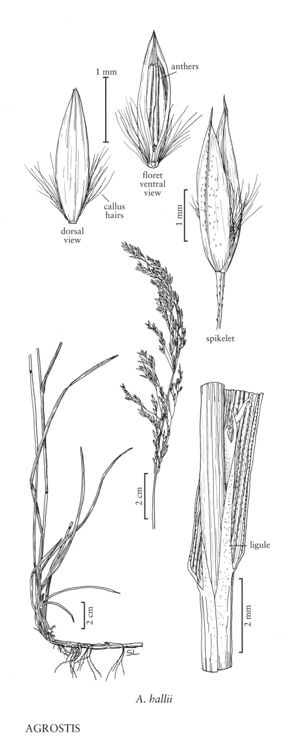Agrostis hallii
Plants perennial; rhizomatous, rhizomes to 50 cm, not stoloniferous. Culms 17-100 cm, erect. Leaves mostly cauline or somewhat basally concentrated; sheaths smooth; ligules 2.3-7 mm, dorsal surfaces scabrous, apices acute, usually lacerate; blades 6-20 cm long, 2-5 mm wide, flat. Panicles 7-22 cm long, 1.5-5.5 (7) cm wide, lanceolate to narrowly ovate, more or less open to dense, lowest node with 2-15 branches; branches scabridulous, ascending to more or less appressed, mostly branching at or above midlength, some branching near the base, lower branches 1-5 cm; pedicels 0.5-6 mm. Spikelets lanceolate, yellow-green, often tinged with purple. Glumes equal to subequal, 2.5-4 mm, 1-veined, scabrous to scabridulous on the midvein, at least distally, sometimes also sparsely scabridulous over the back, acute to acuminate; callus hairs (0.8) 1-2 mm, abundant, conspicuous; lemmas 2-3 mm, smooth, translucent to opaque, 5-veined, veins prominent at least distally, apices acute, entire or erose, sometimes toothed, teeth to about 0.2 mm, unawned; paleas absent, or to 0.2 mm and thin; anthers 3,1.5-2.3 mm. Caryopses 1.5-2 mm. 2n = 42.
Distribution
Calif., Oreg., Wash.
Discussion
Agrostis hallii is primarily coastal, growing in open areas of oak and coniferous forests in Oregon and California.
Selected References
None.
Lower Taxa
"decumbent" is not a number.
